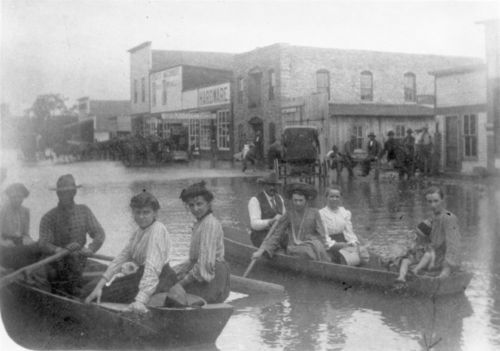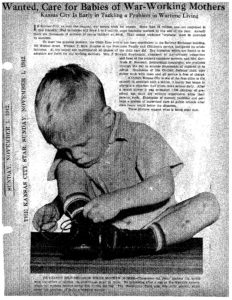A Cornerstone of Kansas City
A History of The Family Conservancy
A History of The Family Conservancy in Kansas City
The Family Conservancy’s history begins nine years before Kansas City would adopt its current name. While the challenges we address today are much different than those the organization was designed to address back in 1880, it isn’t hard to see how an organization created in response to a rapid population boom became the proactive organization you see today, who is focused on building strong families and ensuring children enter kindergarten ready to learn.
Beginning with the completion of the first railroad bridge over the Missouri River in 1869 — connecting to what is known today as the River Market neighborhood — the area’s population would quadruple over the next 50 years. While the rapid growth helped establish Kansas City as a railroad hub and thriving cattle town, this population boom created new problems for the burgeoning metro.
In response, Father William J. Dalton invited 19 prominent citizens to the Coates House Hotel to form the Provident Association in 1880. In the early years, the organization focused on meeting the basic needs of unemployed and impoverished residents and addressing what was described as “an infestation of beggars.1” The charter motto established the Provident Association as a “friend of the sick and poor” for Kansas Citians in need.

Direct relief was provided for the incapacitated, and employment for the able-bodied. In 1884, an employment program was established. Men sawed wood in exchange for groceries, clothing and heating fuel. In 1889, the program was expanded to include sewing and laundry work for women.
During the early years, the organization also raised and dispensed funds in response to disasters, wars and depressions. From 1880 to 1935, in response to three smallpox epidemics, four major floods, three depressions, two wars and private despairs too numerous to count, nearly 300,000 people were served.2
The Great Depression of the 1930s brought more hardship to the region. In response, the Provident Association partnered with the Kansas City, Missouri Parent Teacher Association to begin a program called Mutual Help, to provide clothing to low-income, school-aged children. By the end of 1931, daily intakes for food and clothing assistance exceed 100 families per day, and by 1936, three million dollars worth of food had been distributed. In 1937 the agency also established a program to help homeless boys find employment.
By 1940, 12 million American women entered the workforce in support of the war effort. While the jobs helped area families recover from the Great Depression, the war brought new challenges to Kansas City. Referred to as “work time orphans,” it was estimated that 1,500 preschool-aged children in Kansas City were without supervision while their parents worked.3 In July 1942, the organization opened a child care information center to help mothers find care for their children while they worked. The organization also trained volunteer child care providers and conducted a door-to-door survey to ensure that children of working mothers had adequate care.4 5

As the war came to an end and soldiers returned to family life, the demand for mental health services across the country were high. In 1946, the federal government responded by passing the National Mental Health Act. The law provided funding to train therapists and marked a shift from addressing only severe mental health issues treated by psychiatrists, to providing outpatient mental health services by non-M.D. therapists.6 While mental health services were provided by the agency prior to 1950, the shift in the way Americans viewed mental health therapy created new demand and opened the door for the organization to expand its services. Counseling offices were established in Jackson County, Missouri; North Kansas City; and in Johnson County, Kansas, in the 1950s. By 1978, the agency was providing therapy to about 10,000 individuals and families year. Services addressed a variety of challenges including alcoholism, parenting and family troubles, and abuse — many of the same challenges TFC therapists address today.
A partnership with the Kiwanis Club was established to create a group home for young boys in 1951. The group home provided housing and casework to help children graduate from high school. The program quickly expanded to meet additional needs of these youth. Partnering with professional Kiwanians, dental care, eye exams and other health services were provided. In 1965, another group home was opened to serve girls. While the group homes are no longer offered, the partnership with the Kiwanis Club still exists today, and case management is provided throughout the metro to homeless high school students.
While TFC’s roots in parent and caregiver education can be seen prior to 1960, they began to take formal shape when partnerships with various social and health agencies were formed in 1965. The resulting family education program provided speakers for outside groups such as PTAs, schools and the juvenile court system.
In 1971, A metro-wide telephone counseling hotline was established. Each month, 1,700 calls were fielded on topics including dating, loneliness, parent-child conflict, drugs and sex.
At the agency’s 100th anniversary celebration, a center dedicated to family enrichment was announced. The new center, operated by trained staff and volunteers, was designed to help families and individuals anticipate and cope with life’s challenges. The opening was touted as a departure from crisis-oriented programming to a preventative focus for the agency.
In 1983, the organization adopted The Minnesota Early Learning Design Program (MELD), which provided education to new parents through long-term support groups. MELD focused on helping parents teach their children good learning habits early in life.
From 1960 to 1980, the number of women in the workforce doubled.7 With more mothers entering the workforce and an increase in national concern for “latchkey kids,” a three-year project was launched to provide start-up funding to nonprofit child care centers and to increase the availability of quality child care. The number of women in the workforce continues to rise today. From 1980 to 2015, the number rose by 60 percent and The Family Conservancy (TFC) is still working to increase the number of high-quality child care programs in our community.
Following the stock market crash of 1987 and resulting financial hardship, Family and Children Services of Kansas City, Inc. merged with Family and Children’s Services of Wyandotte County to become Heart of America Family Services. Family and Children’s Services of Wyandotte County was founded in 1902, as Associated Charities. Famed prohibitionist Carry Nation served as an original board member of the Wyandotte County agency, and helped organize one of their first programs — a home for abused wives of alcoholics. While the two organizations had different origins, by time of the merger, their services were very similar. Both organizations provided child care resource and referral services, parenting and family education and counseling.8 The merger marked the creation of the first major philanthropic organization serving the Kansas City metro are on both sides of the state line and saved an estimated $70,000 a year in administration costs.
Driven by growing research highlighting the importance of the first five years of life, including an examination of interactions between caregivers and children in different socioeconomic classes conducted by researchers with the Juniper Gardens Children’s Project, the organization began to shift its focus toward preparing young children for success in school. Released in 1995, the study highlights the importance of early experiences, the environments in which young children develop, and how the early years can have lasting impact on later success in school and life. This research, along with many others studies examining the importance and value of early learning, has guided many of the agency’s programming decisions.
In 1997, an accreditation project for child care programs was launched. When it was first piloted, only 17 of the 500 area programs were nationally accredited. Today, more than 50 early education programs in the Kansas City community are nationally accredited and approximately 40 programs have achieved state accreditation.
In 2005 at the 125th anniversary celebration, the organization announced the rebranding that brings the agency’s identity, which is still known today, as The Family Conservancy (TFC).
Also in 2005, TFC became a Head Start delegate in Missouri. Through this contract, administered by Mid-America Regional Council, over the last 12 years, more than 12,000 Missouri children have benefitted from Head Start’s holistic approach to child development.
In 2010, TFC relocated to the Children’s Campus of Kansas City (CCKC). The campus resulted from a partnership between TFC, Project Eagle and Juniper Gardens Children’s Project to create a full service entity for young children and their families in the urban Kansas City area. The facility, whose planning committee was established nearly 10 years before the campus broke ground, fosters collaboration and increases efficiency. Focusing on the agencies’ shared areas of impact, the CCKC partners launched the Talk, Read, Play … with your child every day, community awareness campaign shortly after moving into the new facility. Talk, Read, Play continues today to educate parents and caregivers about the important role interactions like talking, reading and playing have in the healthy brain development of young children.
TFC Head Start services were expanded in 2015, when the agency received an Early Head Start-Child Care Partnership grant. Since 2015, this funding has allowed TFC to provide community-based Early Head Start services to more than 100 Kansas children, birth to age 3, and their families, each year. This funding and TFC’s support has also brought facility improvements and renovations to these child care providers to promote safe and healthy learning environments and in increase their capacity and ability to provide high-quality early care and education.
Today, The Family Conservancy applies a comprehensive approach. The organization is focused on equipping parents, teachers and caregivers with the resources and information they need to prepare young children for success in school and life.9 A diverse menu of services offers bilingual mental health services, parenting education and resources, and professional development for preschool teachers and child care providers.
One hundred and thirty-eight years later the trend of responding to the community’s greatest needs continues. Over the years, the approach has grown in response to societal, political and economic change, and a broadened understanding. The organization has grown from its reactive conception to a proactive organization focused on building strong families and ensuring children are prepared for success in school and life.
- Kansas City Journal January 30, 1909
- Photo 1903 flood Kansas Historical Society
- Kansas City Star November 1, 1942
- Kansas City Star July 12, 1942
- Kansas City Times August 7, 1942
- Ronald W. Dworkin, “Psychotherapy and the Pursuit of Happiness,” The New Atlantis, Number 35, Spring 2012, pp. 69-83.
- U.S. Department of Labor
- Heart of America Family Services 1987 Annual Report
- Hart, B., & Risley, T. (1995). Meaningful differences in the everyday experiences of young American children. Baltimore, MD: Brookes.

